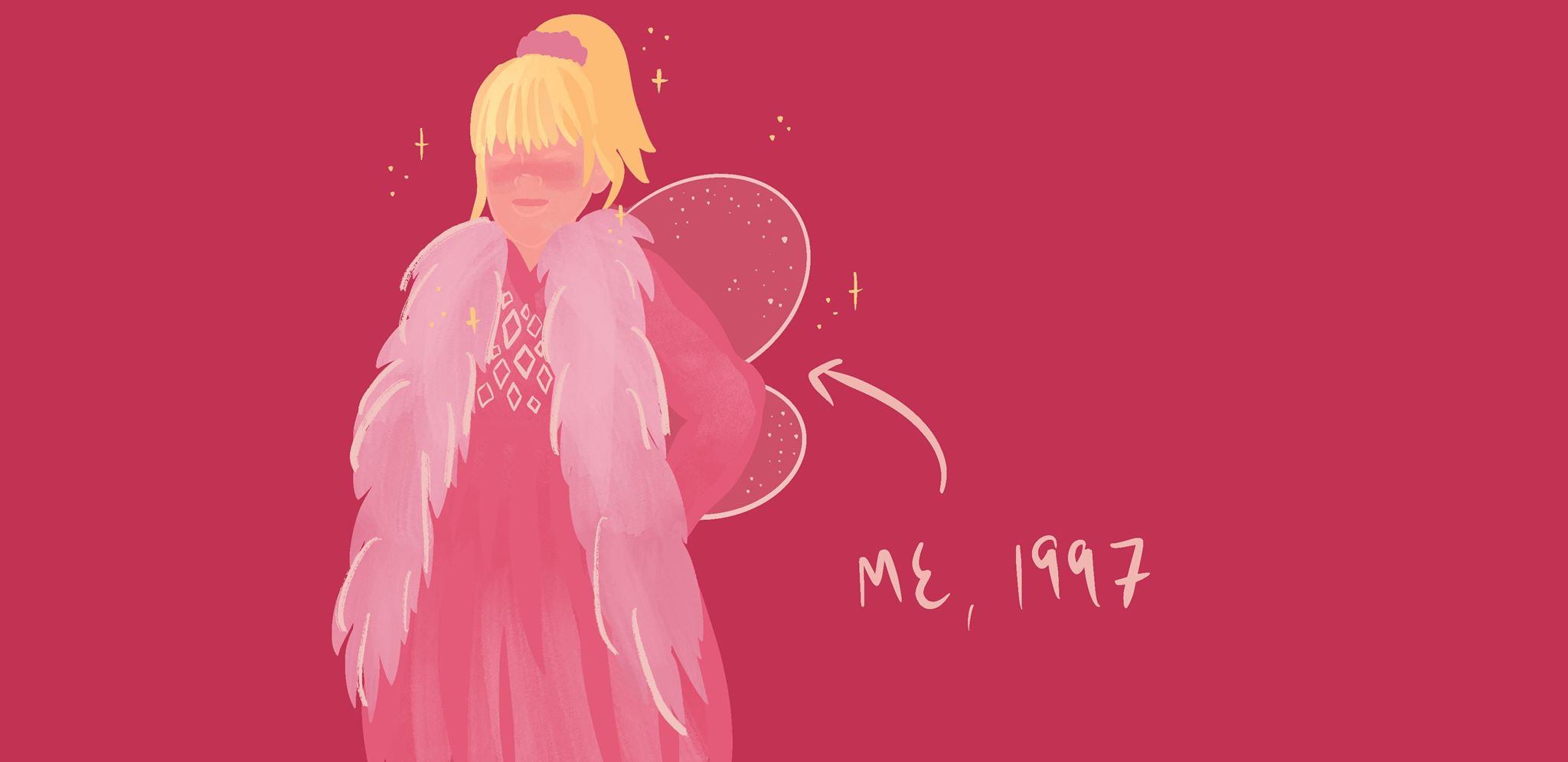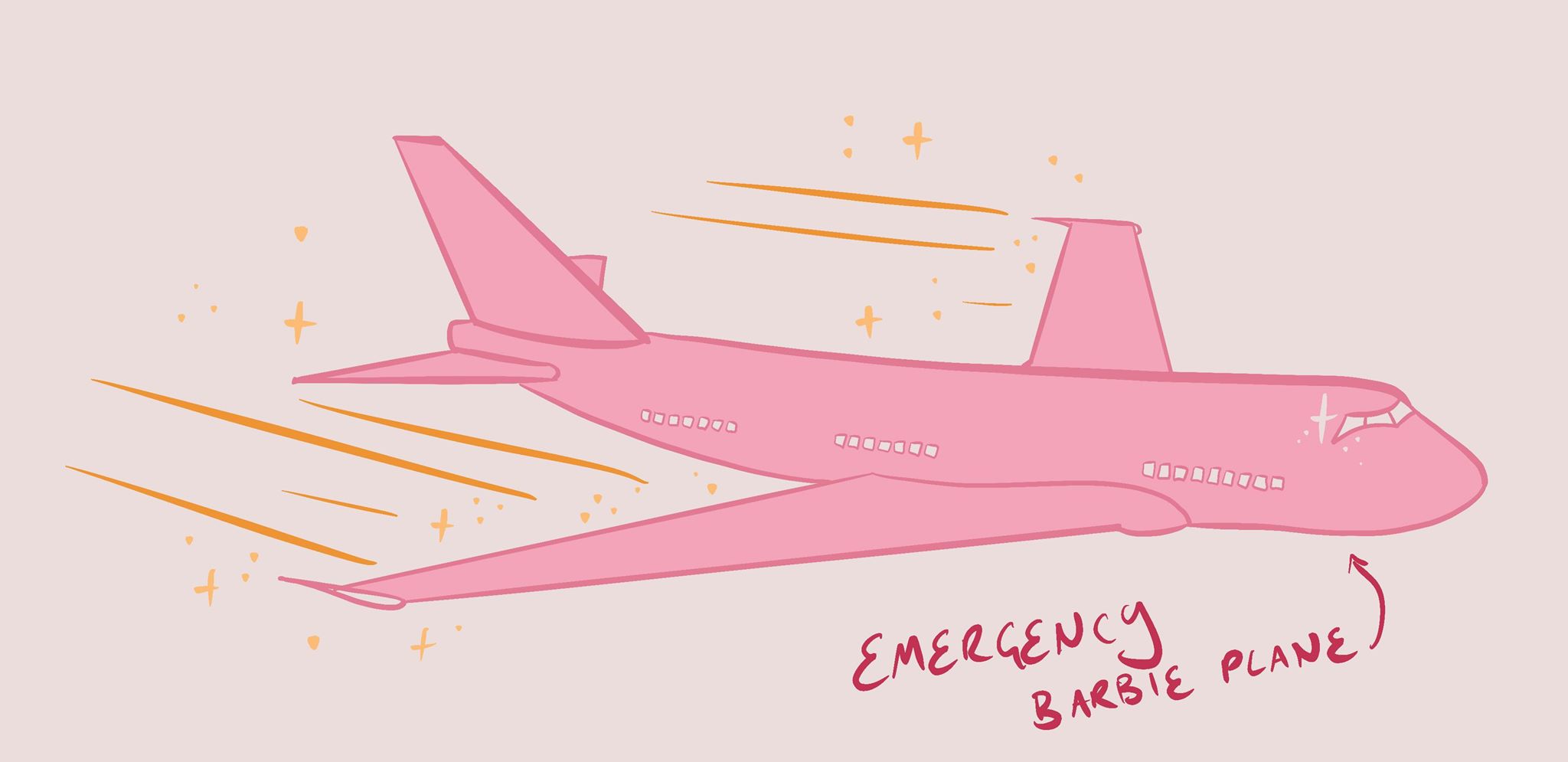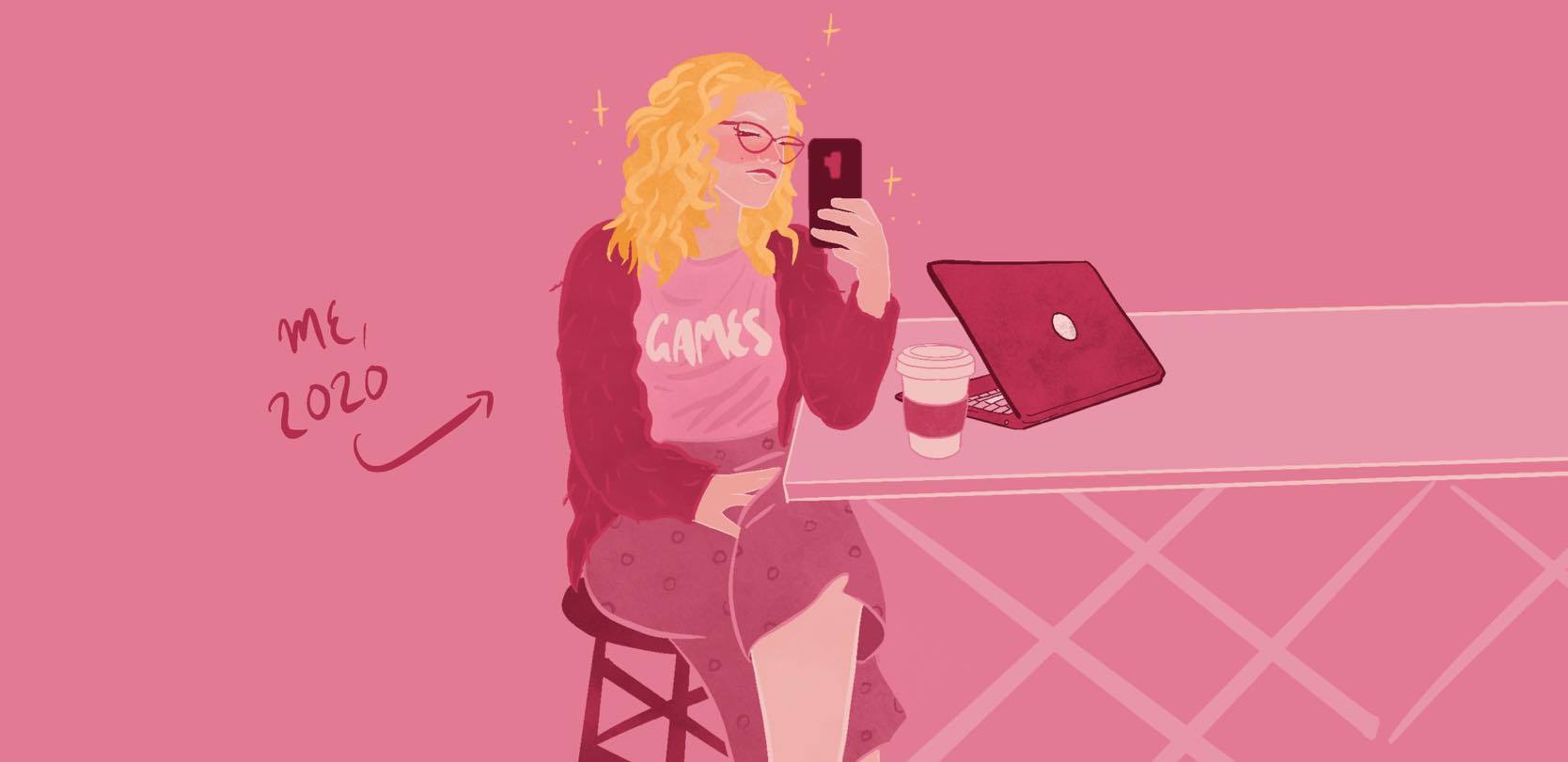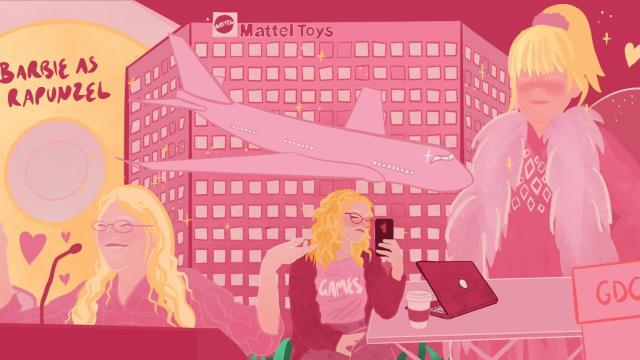In the late 90’s, amongst a wave of all-new “Games for Girls”, Barbie appeared on CD-ROM for the first time. I was five, dressed in a timeless bejeweled-satin-homemade-princess-gown-and-feather-boa combo. I was squarely within the target audience for the first ever Barbie fantasy video game.
Magic Fairy Tales: Barbie as Rapunzel is burned into my memory. It’s a virtual storybook, similar to the beloved Lion King game. Wikipedia says the game was “designed to teach children early reading and decision-making skills”. I’d say Magic Fairy Tales Barbie was a mildly unhinged collection of mini-games that let you decorate cakes, dress up, practice diplomacy with a troll and a dragon, and rescue a Prince.
This article has been updated since its original publication.
I loved it, I re-played the game endlessly, and I still see the talking magic mirror in my dreams. I never anticipated that more than twenty years later, this game would hold a treasure trove of insight into my own game development experience.
I’m now a game developer, meaning my afternoons are sometimes spent researching why a particular type of button reminds me of my childhood (I love this job). During one such occasion, I discovered a YouTube playthrough of Barbie as Rapunzel. If you’re planning on doing this too, I should warn you that Rapunzel’s bird sidekick is named Twitter which does colour their interactions, locked together away from other people, with an alarmingly 2020 lockdown vibe.
Skipping to the credits, I was struck by how many women worked on the game.
So I started reaching out to the developers. I expected to hear stories about a time before patches, or the pain of developing games in Adobe Shockwave. What I didn’t expect was tales of decades-long industry feuds, of secretive off-the-books animated films, heckling at industry events like the Game Developers Conference (GDC) and, ultimately, a team’s triumph over conventional wisdom.

Let’s start, as I did, with Jesyca Durchin.
Durchin was the first Barbie as Rapunzel dev I tracked down. She responded to my Facebook post in a global game developer’s group almost immediately. I quickly learned that her career went far beyond this game! After working on Barbie as Rapunzel as an Associate Producer, Durchin would become Mattel’s Director of Girls Content, be an Imagineer at Disney, and is now a Creative Producer at Universal.
When she started working at Mattel Media, Durchin was my age, in her mid-twenties. But in 1997, she says, nobody you asked at Mattel could tell you what this small group of creatives, mostly women, were making in a separate office hidden away in an old rug factory down the street from Mattel’s headquarters.
In my research — many nights spent trawling through LinkedIn, dodgy scans of magazine articles and books from the 90’s, and squeezing the GDC Vault for all it’s worth — I’ve heard this group of people called a lot of things: the first indies, bad feminists, experimental game designers, marketing scammers. This was not what I was expecting.
Barbie is a cultural icon. How could a studio working on Barbie be considered underdogs?
Skunkworks

It was 1997. Aqua’s Barbie Girl was number one on the music charts. Mattel was about to sue for the song. Barbie was big.
“At the time, it was one of the most valuable brands in the world, like second to Coke,” Cynthia Woll, the game’s executive producer and my new hero – we’ll get to that – told me.
Video games were also about to go mainstream. The Nintendo 64 had just released in Europe and Australia, as well as some of the industry’s biggest IPs: Fallout, Tomb Raider 2, Mario Kart 64. These games are beloved to this day, universally acclaimed as all-time classics.
It was a seminal time for video games, and Barbie was about to enter the thunderdome.
Barbie wasn’t Mattel’s first foray into games. “Mattel had been in the gaming space with this hardware platform Intellivision,” said Lauren Berzins Kelly, who worked in Mattel’s marketing and product management in the late ’90s, said.
“It had been a big fiasco failure. So people were curious about what we were doing [with Barbie], but they didn’t want to align with us because there was a big distrust that we could do this.”
All the former Mattel Media employees I met said the distrust was a common theme. Their exciting new venture was not something people at Mattel wanted to hitch their wagon to. “Mattel was so worried about this, they were like, ‘Don’t tell anybody what you’re doing,’” Durchin said in a GDC retrospective.
“They created a small company, like a startup, within this big company of Mattel. We were in a different building, we were down the street.”
Woll remembers those humble beginnings too. “When we started, it was just a small little team. We were like a dozen people or something like that,” Woll said. “This was all before Barbie Fashion Designer came out. So Mattel still saw us as kind of a skunkworks, this isn’t going anywhere, whatever.”
“It was magic making these games. We didn’t have to answer to anybody, we were just making games that we thought girls would like,” Durchin said.
The Hits

Mattel Media wasn’t just a startup in size but philosophy, according to former employees. Nancy S. Martin and Andy Rifkin, the leaders of Mattel Media, were talking about their mission for the products in modern Silicon-Valley-speak.
“Nancy Martin always was an innovative thinker … they [Martin and Rifkin] were like, let’s disrupt and let’s do innovative things,” Kelly said.
It wasn’t only software. The team launched the first mass-produced digital camera for kids, the Barbie Digital Camera. “In the building, we had a research centre where we would bring in kids and sit behind the glass … and we were trying to figure out how to position [the Barbie Digital Camera],” Kelly said.
“After we launched it, we had so much demand, we sold over five hundred thousand units, I actually had to help how to figure out how to get more of all the play pieces that were in it … we ended up having to fly a plane from China to get the product!”
“We thought the girls would all want to be the model, and what came out was the girls all wanted to be the photographer. It makes me want to cry! … It’s not about getting your picture taken, it’s about empowering girls to take the picture and be the inventor. It completely changed our perspective.”
The findings from this research were fed back into how the products were developed. “The products were really designed for the end user. It was User Experience before there was User Experience.” This user-focused approach paid off. Barbie Fashion Designer, an idea first pitched by the daughter of a Mattel executive, was the gamechanger for Mattel Media.
“Between that October and the following year, we went from having zero revenue to having $US100 ($139) million in revenue from Barbie titles. That made Mattel notice us,” Cynthia (“Hero”) Woll said.
The Worst Game We Made
Now that the ball was well and truly rolling for Mattel Media, the team decided to make a Barbie CD-ROM, in the style of the highly successful animated storybooks of the era.
Mattel Media outsourced their game development, hiring Media Station — a small team in Ann Arbour responsible for the Disney Animated Storybooks — to work on Barbie as Rapunzel. The team were pretty cutting edge for their time, having developed proprietary tools to improve the animation quality and speed of development specifically for this flavour of educational game. They were the storybook experts! What could go wrong?
To find out, Woll, my hero (we’re getting to that) tells me I need to talk to Aaron Hinklin, who was a producer at Media Station. Before we dove into the development process, Aaron tells me about a Facebook group of former Media Station employees where he’d posted that I was working on this story.
“No offence to your article, but Barbie as Rapunzel is probably the worst title we did! So everyone is like, ‘Why is she doing Barbie as Rapunzel?’”
I’ve produced my own slate of video games. I understand that every production is challenging! Making a game is a ridiculous venture for all involved. But this precious, bizarre game that altered the course of my creative life? Having spent an hour on Zoom with Aaron, it sounds like it was an honest-to-God nightmare.
Let’s start with the money. Barbie as Rapunzel was a significantly lower budget project than Media Station were accustomed to. Budgets on a Disney animated storybook would range from $US1.5 ($2) million to $US2 ($3) million, whereas the budget for Barbie as Rapunzel was a mere $US500,000 ($694,150).
That was only the beginning of the team’s woes. “I do mention Barbie as Rapunzel to people because it was such a horrendous mess when I took it over,” Hinklin tells me.
The biggest problem, Hinklin said, was the animation. Media Station was working with an external animation studio in Chicago, but the quality of the work was astronomically poor. “We had a joint venture with an animation company in Chicago, and they were doing their own animated movie off the books, so instead of doing the Barbie as Rapunzel work they shipped it overseas … and then tried to pass off the animation as their own,” Hinklin said.
This was a game starring the figurehead of Mattel, Barbie. It had to be right. But as Woll describes, the work was disastrous.
“We spent so much time talking about Barbie’s eyes,” Hinklin laughed. He’s laughing now, but at the time this was a disaster. This was one of the first times Mattel would see Barbie, the figurehead of their brand, as big as Coca-Cola, in 2D animation – and she looked horrible. Something had to be done, or everyone was going down with the ship.
Like Nintendo, LucasArts or Disney, Mattel had a special Barbie committee to approve or veto anything that touched the Barbie brand. If the animation wasn’t good enough, the whole project was at risk. So Media Station animators worked overtime to fix the Barbie animations.
“Cynthia and I ploughed through it and got it done … so that kids may have memories of it and not be traumatised by it,” Aaron laughed.
When it was finally done, it was up to Aaron to deliver the gold master to Mattel Media. He still has a gold CD-ROM master for Barbie as Rapunzel, and he shows me in our video call. “It would take like 45 minutes to an hour to burn these, and then I would drive 40 minutes to the Detroit Metro airport, and stand in line at Northwest Direct, and ship these to LA.”
It seems wild imagining this process now, in a world with almost instantaneous global playtesting and digital distribution. “I’d be standing in line with guys who had like human hearts and lungs … It was all very urgent.”
Against all odds — as all games are — Barbie as Rapunzel shipped. Hopefully not at the cost of a heart transplant.
But the rollercoaster didn’t end there.
The GDC Incident
Barbie as Rapunzel was broadly successful when it shipped, and some media praised its supposedly progressive narrative. The Orlando Sentinel wrote:
“But the days of the damsels in distress may be over. Young girls can become the fearless heroine, playing Barbie in Mattel Media’s early-reading interactive storybook adventure, Barbie Magic Fairy Tales: Barbie as Rapunzel.”
Not everyone loved the game as much as five year old me, though. In the Chicago Tribune, Karen Torme Olson criticised Barbie as Rapunzel for not being empowering enough:
“The term “Barbie doll” has come to describe the type of woman who is fluffy and fashionable, beautiful but brainless — anything but strong and empowered. Yet a new CD-ROM titled “Barbie Magic Fairy Tales: Barbie As Rapunzel” purports to effect a role reversal that casts Barbie as an independent woman — a fearless heroine who saves a prince from an evil witch’s spell. Yes and no. … There are lessons to be learned here, but they have nothing to do with inspiring girls to want to become strong, independent women.”
Karen wasn’t alone in her criticism of Barbie as Rapunzel and games for girls in general. When Ernest Adams, author of Fundamentals of Game Design wrote “Games for Girls? Eeeeewwww!” In 1998, the article was so spicy it initiated a 20 year cold shoulder from Purple Moon founder and leader of the Games for Girls movement Brenda Laurel.
I didn’t exactly expect to hear back from Adams when I emailed him out of the blue to hear more about this, but to my surprise I found myself on a Zoom call with him a few days later.
“[Games for girls] were a very poor deal,” he told me, explaining his thinking behind the divisive article. “They only offered very few hours of gameplay, yet they cost the same amount as a big game from the more conventional genres that offered thirty or forty hours of gameplay. So I really felt like this was kind of a scam. These companies were making these games and putting them in pink boxes, and telling parents, ‘Oh, finally there are games for girls!’”
The year after Barbie as Rapunzel came out, at GDC (a conference that my new friend Adams jointly owned at the time) Jesyca Durchin gave a talk about girls multisensory interface design. “What I was discovering was that real girls react differently to things that regular game designers might not know, and I wanted to describe that in the talk,” Durchin told me.
The talk did not go as planned.
“I would say I didn’t go into it with a lot of self-awareness, I went into it with a lot of pride and excitement.” Durchin admits. “I gave this talk, and I talked about the importance of lipstick colours, and nails, and that what girls wanted were choices. … In Barbie Fashion Designer, you don’t actually make the fashion, you select the options. So you’re not really a designer, you’re more of a stylist.”
“My position, especially at that time, was that was enough for a little girl. That she could feel like a fashion designer, I’m not gonna tell her, “You’re not a fashion designer, you’re just a stylist.”
This is the topic Durchin thinks kicked it all off. What was or wasn’t enough for little girls?
“Somebody stood up and said that I was rotting his child’s mind. I remember thinking that maybe he was kidding and that I was getting Punk’d. I remember thinking this might be a joke. And then, another woman stood up and said she belonged to this group, and that I was the worst example of women who like games. And it was just awful. I was really surprised. I listened, it got heated.”
Adams, who attended Durchin’s talk and would later quote it in his book, remembers the incident. “Behind that [heckling] there was kind of a little bit of ill-informed ‘Well, dolls are a girl thing and we should try to suppress them in order to turn them into engineers,’” he said over Zoom. “It was ‘We don’t think these kinds of games should exist because we don’t think those kinds of toys should exist, because we think Barbie is bad for girls.’”
Adams remembers that era of gaming with a kind of bemusement. But as we talk more about the legacy of the games for girls movement, he describes Durchin’s talk, and her work, as “on the trailing edge of a movement that wasn’t quite ready to accept her yet”.
“My parents are archaeologists, and I grew up on digs in the Nile Valley in Egypt and Sudan, and from time to time we would dig up a doll. A doll in that context was two pieces of wood crossed to make a body and arms, and then held together with a little bit of twine,” Adams recalls.
“Now that would be about 800-900 years ago, somebody was running around this medieval Sudanese city carrying this little wooden doll, back then. That’s nothing to do with modern consumerism. Dolls are going to exist, and therefore games with doll themes are going to exist, and there’s no point in trying to suppress them out of a misplaced sense of what’s right for girls.”
This sentiment also failed to identify how successful games for girls could be. Ernest remembers pitching a horse game to EA Sports in 1995. “I’ve had this great idea, you know there’s a lot of horse sports,” Ernest said. “No-one’s ever done it, and if we did that we would own every little girl in the world.’ And I was told “Oh no, we’re not interested in that, girls don’t play video games. We don’t care, it’s not worth the trouble.’”
“So what happens? That Christmas, Barbie Horseriding Adventure came out. And for one week before Christmas it was the top seller among PC games. And that was a great big stack of money that EA Sports could have had and passed on.”
Barbie As Rapunzel’s Legacy
There are many ways the games industry has moved mountains since Barbie as Rapunzel. We’re not standing in line with human organs to ship a gold master anymore. However the stories of the kind of resistance met by the people creating this game, the story of Mattel Media, speaks to a destination we are yet to reach. I spoke with Cynthia Woll about this (it’s time!).
Perhaps the best illustration of how poorly the industry understood the games for girls movement could be found in the genuine excitement Cynthia Woll had when she interviewed at Mattel Media. Woll was an experienced producer before she worked on Barbie as Rapunzel. She loved Barbie. She became a seamstress when she was younger. Built educational games for Disney, and worked in tech for online shopping.
“When I saw Barbie Fashion Designer, I was like, ‘It’s pattern making, it’s 2D into 3D, it’s Barbie. The best thing ever,’” Woll told me over Zoom. “It’s maths, and science, and Barbie all in one. Wow, that’s all the stuff I know how to do.”
But Woll never saw herself as part of the video games industry, only the toy industry. Mattel Media’s presence became quickly known, however. In 1995, the company’s E3 booth was so small it was almost impossible to identify them on the official floor map.
By 1997, Mattel Media was exhibiting next to Konami and Castlevania: Symphony of the Night.
When asked about the wave of games industry credentials-checking that followed Mattel Media’s rise, Woll remembers a lot of “hurt feelings” and legitimacy questions about game development. The reality that cut through it all was how games treated people outside of the presumed norm.
“The thing that really affected many of us was employment, and how do you get a job in an industry that looks at you and says, ‘Well, you’re nothing,’” Woll said. “Once you have the job, how do you progress in an industry that looks at you and says you’re nothing? Or worse, an industry that looks at you and says, “You’re less than human to me.” Or, ‘You’re somebody that I can abuse.’”
Woll later moved to Atari to work on D&D Online as an executive producer, and today she works as an Adjunct Assistant Professor at the University of Southern California. Using Dungeons & Dragons as an example, Woll explains the similarities between how people enjoy tabletop RPGs and Barbie.
“To this day I look at D&D and I go, it’s just like Barbie, it’s aspirational role play. And it’s filled with jewelled accessories,” Woll explains. “And myself personally have always seen the industry that way … I really understand what role play is because Barbie is role play. It’s just role play with different characters.”
“The idea of why it is a game, and why is it appealing to people, and why is it fun are the same.”
I mention the number of women in Barbie as Rapunzel’s credits, and say to Woll how many studios still struggle with hiring and retaining workers who aren’t cisgender men. Cynthia gives me the closest thing to a knowing smile that I think is possible via a Zoom call, which breaks my heart a little bit.
“The thing is, that we don’t allow for enough kinds of real selves. That’s the only way you’re going to get any quality of anything. If you are your real self, and if you’re able to bring your real self to work and say, “This is what I actually like, I really like pink. I literally do.” Versus, “I have to pretend to be something that I’m not in order to get a job, or keep a job, or get promoted.”
When Woll tells me this, I’m reminded of a quote from Mattel Media’s Nancie S. Martin:
“I have this sort of mission, if you will, that I want all those girls who are now six and seven, when they’re twenty-six and thirty-six and forty-six, to still be using computers as a tool, and to remember that it’s all because of Barbie.”
FROM BARBIE TO MORTAL KOMBAT: GENDER AND COMPUTER GAMES, EDITED BY JUSTINE CASSELL AND HENRY JENKINS
Statistically speaking, Martin is talking about me. I’m her target consumer. I certainly absorbed the games’ creative influence.
And while Barbie undeniably has its own cultural baggage and damage, Barbie as Rapunzel took the things I loved at the time and brought them into a new medium that was mine for the taking.
It was no less meaningful or legitimate to me than Fallout, Final Fantasy 7, or Monkey Island. It was weird, funny, sparkly, pink, and it was mine.
Hearing about the struggle and the joy it took to bring these games to life is a welcome reminder of my own responsibility as a creator. It’s our job to open up worlds for players who don’t yet see the things they love in games.
Gender is more nuanced than the late 90’s Barbie debate suggested. Neither shunning Barbie or digitising her would ever deliver us an utopian equality. What’s more meaningful to me is what the early days of Mattel Media represent. That when people can bring their full selves to work they can make beautiful, bizarre and lasting games.
When Nancie S. Martin says “it’s all because of Barbie,” I choose to think she’s talking about Wall, Durchin, Kelly and all the workers who made these products against the odds, just so someone like me could fall in love with video games.
Durchin thinks the games industry has come a long way from a time where she was often the only woman in the room, or the only Latina in the building. We still have a long way to go for all game creators, whether they love pink or not, to bring their full selves to their work. But I’m comforted by the progress Durchin sees.
“What do you think the legacy of these games is?” I asked Durchin.
“I guess, you.”

Ally McLean is an Australian game producer and founder of The Working Lunch, having previously served as the Gamerunner on RUMU. She currently works as an expert Product Manager at Wargaming Sydney.

Leave a Reply